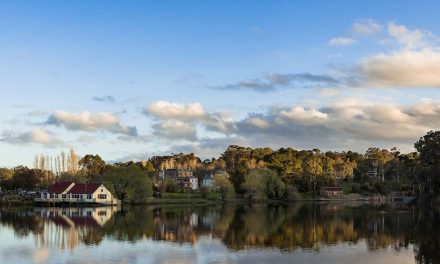The Gold Heritage Walk is one of those little hiking surprises that you stumble across every so often. Right beside the pretty outer-suburban village of Warrandyte, a network of walking trails reveals stories from the area’s gold mining past.
Whipstick Gully was the site of Victoria’s first gold discovery in 1851, and it wasn’t long before Andersons Creek (now known as Warrandyte) was home to around 250 miners. By the time mining was abandoned, Fourth Hill and much of its surrounds were nearly completely cleared and the entire region was dotted with mines and diggings, machinery, and makeshift shacks.
Fortunately, after many decades of neglect, the 620-hectare Warrandyte State Park was declared here in 1975. Now 45 years of protection has allowed nature to do its thing. The bush has regenerated and with that, the wildlife has returned. Together they’re slowly reclaiming these relics from a different time.
Aside from the history, hikers on the Gold Heritage Walk can expect to see birds galore, kangaroos, maybe an echidna if you’re lucky, and the most incredible wildflowers in spring. You’ll take on a few decent inclines so be prepared for a good workout.
The tracks and signage are a little tricky in places. I couldn’t find a proper 1:25,000 topographic map of the area but matching my location on google maps to the map I’ve linked below is what worked for me. Don’t stress too much if you lose a track completely as there are other tracks that intersect and will easily send you in the right direction as long as you keep a close eye on your Google Maps location.
The walk is best completed in a figure-eight, starting from Whipstick Gully Carpark and heading to the right on Bruce Bence Track (next to the information shelter). This leads you up a damp valley following a creek before looping back and meeting Whipstick Gully Track.
Take a right on this wide management vehicle track and at the next intersection, continue onto Wildcat Gully Track. You’ll soon come across Geraghty’s Mine (established in 1859), the first large-scale mining operation on Fourth Hill. This will be the first of many mining relics you’ll come across and nearly all of them are signed with interesting historical information.
Continue on and you’ll soon come to another intersection, where you should turn right onto an unsigned track, cross a short boardwalk and then climb steeply uphill. This section is almost like a gold heritage gallery, so make sure you keep your eyes peeled for relics. You can’t miss the old miner’s hut (pictured below).
The next intersection is where this track meets another management vehicle track called Betton Track, near the summit of Fourth Hill. It’s only a very short detour here to the summit, but there are no views and nothing particular of interest to see. Instead, head right and descend Fourth Hill to meet Wildcat Gully Track again. Turn left to head back to the car park, taking a quick detour to check out the Victory Mine and remains of an old stamping battery before returning to your vehicle.
Looking for a trail that's longer, closer, or not as challenging?
You need The Trail Finder, where you can filter your way through hundreds of hiking trails.




Need to Know
Map
Last Visited: 2019
Length: 3 km
Time: 1 hr
Grade: East – Moderate / Grade 3 (according to the Australian Walking Track Grading System).
Style Partial Circuit
Region: Melbourne
Park: Warrandyte State Park
Car Access: Access is via Whipstick Gully Road, Warrandyte (Melways Ref: 23 F12). This is off the main street of the Warrandyte township.
Nearby: Mount Lofty is by far the most popular place for a Warrandyte walk, followed closely by Pound Bend. Black Flat and the Jumping Creek Nature Trail are also worth a look. In the warmer months, you might even want to consider a kayaking tour on the nearby Yarra River.
Have you visited the Gold Heritage Walk at Warrandyte State Park? Got it on your bucket list? If you have any stories, updates or corrections, please let us know by commenting below.
Exploring the Great Ocean Road?
You won’t see the best sights from your car. Get the definitive guidebook, featuring the 25 best walks in the area with detailed instructions and maps.






